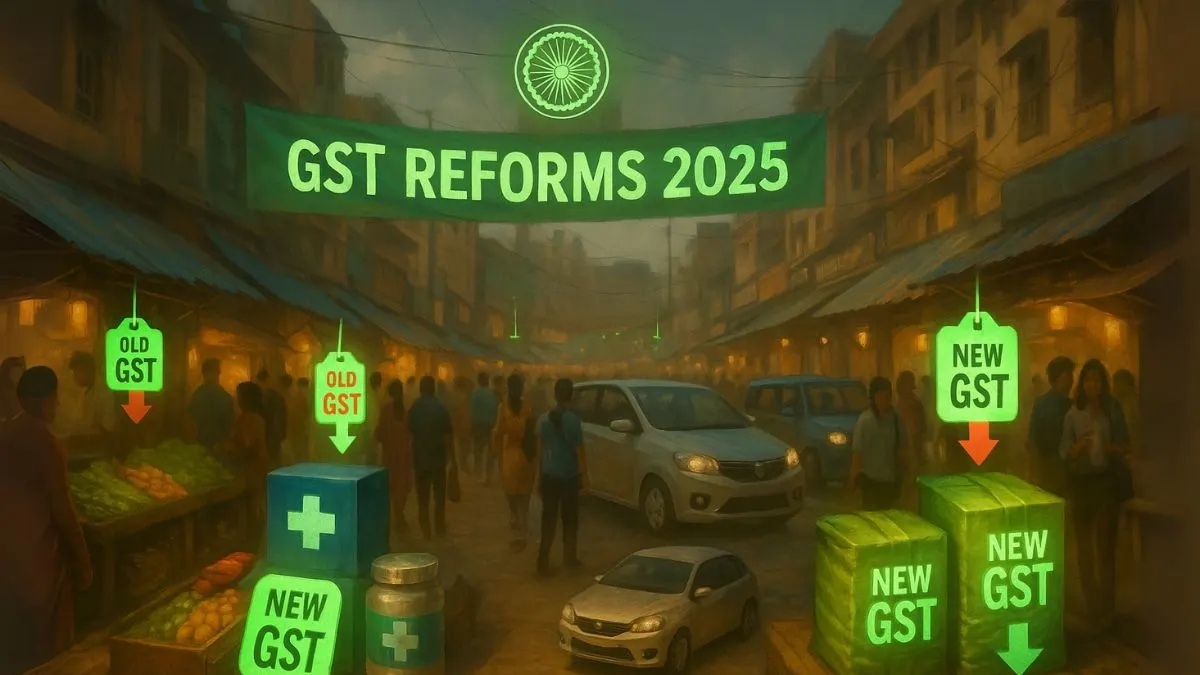
The Goods and Services Tax (GST) has been India’s biggest tax reform since its introduction in 2017. Over the years, it has gone through several changes, but the GST Reforms 2025 are being hailed as one of the most impactful steps toward simplification and fairness. These reforms focus on delivering relief for the common man while creating a more business-friendly environment.
The government has rationalized rates across multiple sectors, cut down on complexities, and ensured that consumers benefit directly through lower prices on essential goods and services. At the same time, businesses gain from a simplified system with fewer slabs, clearer compliance rules, and reduced litigation. Together, these measures represent the vision of relief, simplification, and growth for all.
Relief for the Common Man
For the average Indian household, GST touches almost every purchase—from food & medicines to footwear and education. The GST Reforms 2025 bring direct relief by cutting rates on essential items.
Food products like milk, paneer, biscuits, and even packaged water now attract lower GST. Medicines and healthcare supplies have also moved to the 5% slab, and insurance premiums for health & life are exempt from GST altogether. This ensures that families spend less on necessities and can redirect savings toward better living standards.
Festive shopping has also become more affordable. Footwear under ₹2,500 and garments below ₹2,500 now fall into the 5% bracket. Everyday items like toothpaste, soaps, shampoos, and kitchenware also carry reduced GST, adding meaningful savings for middle-class households."
Simplification of GST Slabs
One of the most significant changes under the GST Reforms 2025 is the reduction of tax slabs. Earlier, the system had four major slabs—5%, 12%, 18%, and 28%. Now, these have been streamlined into just two main categories: 5% for essentials and 18% for most other goods and services, with a separate 40% slab for luxury and sin goods like SUVs, tobacco, and aerated drinks.
This simplification makes GST more predictable for consumers & businesses alike. It reduces confusion, minimizes classification disputes, and makes compliance easier. Importantly, it aligns with the long-term goal of a simpler, unified tax system that promotes transparency and fairness.
Also Read: Bata’s Big Step: GST Cuts Now Mean Cheaper Footwear for You
Boost for Businesses
Businesses are expected to benefit significantly from the GST Reforms 2025. The rationalized tax structure lowers the burden on sectors like construction, automobiles, textiles, and FMCG. For example, cement has moved from the 28% slab to 18%, reducing costs for builders and encouraging faster infrastructure development.
Small businesses, in particular, gain from reduced compliance requirements. Filing procedures have been streamlined, and input tax credit claims are now more transparent. This improves cash flow, reduces litigation, and creates a more level playing field for startups and MSMEs. By cutting unnecessary red tape, the reforms encourage entrepreneurship and long-term investment.
Impact on Key Sectors
- Healthcare
Medicines, oxygen cylinders, bandages, and other essential medical supplies are now taxed at 5% instead of 12%. Insurance premiums for health and life policies are fully exempt. This means better access to affordable healthcare, especially for middle-class & rural families.
- Housing & Infrastructure
With cement now in the 18% slab, construction costs are set to drop. Affordable housing projects will benefit directly, making homes more accessible. Infrastructure projects such as roads, bridges, and metros will also become more cost-efficient, accelerating growth.
- Automobiles
Compact cars & two-wheelers have moved into the 18% bracket, giving relief to buyers. Electric vehicles enjoy a 5% GST, which will boost the adoption of green mobility. However, luxury SUVs & premium vehicles are now taxed at 40%, balancing revenue with affordability."
- Retail & FMCG
From packaged foods to personal care products, GST cuts have made consumer goods more affordable. This not only benefits households but also boosts retail demand, which in turn stimulates economic growth.
Relief Simplification = Growth
The genius of the GST Reforms 2025 lies in the balance between consumer relief & business simplification. By reducing rates on essentials, the government ensures that the common man benefits directly. By streamlining slabs and improving ITC transparency, it ensures businesses find it easier to operate.
Together, these measures boost consumption, investment, and compliance—laying the foundation for long-term economic growth. Industry bodies have already called these reforms a game-changer that aligns with India’s vision of becoming a $5 trillion economy.
Also Read: GST Slash on Instant Coffee: Your Morning Cup Just Got Cheaper
Challenges Ahead
While the reforms are widely welcomed, challenges remain. Businesses must adapt to new ITC norms, and enforcement agencies must ensure smooth implementation. Some sectors, such as luxury retail and large automobiles, may face demand pressure due to the new 40% slab.
However, the overall outlook remains positive. The simplification of slabs reduces ambiguity, while targeted relief ensures that the benefits reach households. If executed well, the reforms will achieve their core promise: relief, simplification, and growth for all."
Final Thoughts
The GST Reforms 2025 are not just another round of tax changes—they represent a decisive shift toward a fairer, simpler, and more inclusive system. For the common man, it means lower prices on daily essentials & healthcare. For businesses, it means fewer hurdles and greater clarity. And for the economy, it means stronger demand, faster infrastructure growth, and a more competitive market.
In essence, these reforms deliver what they promised: relief for the common man and a boost for businesses.











